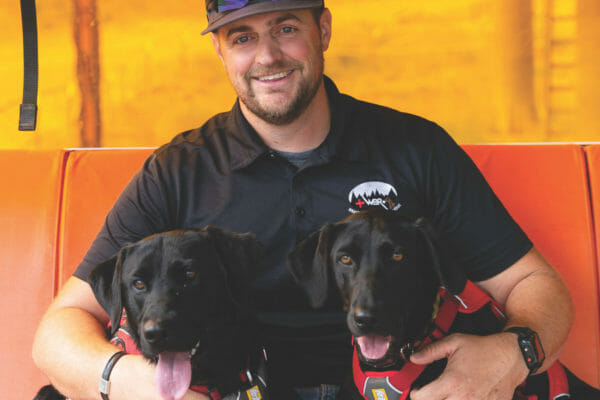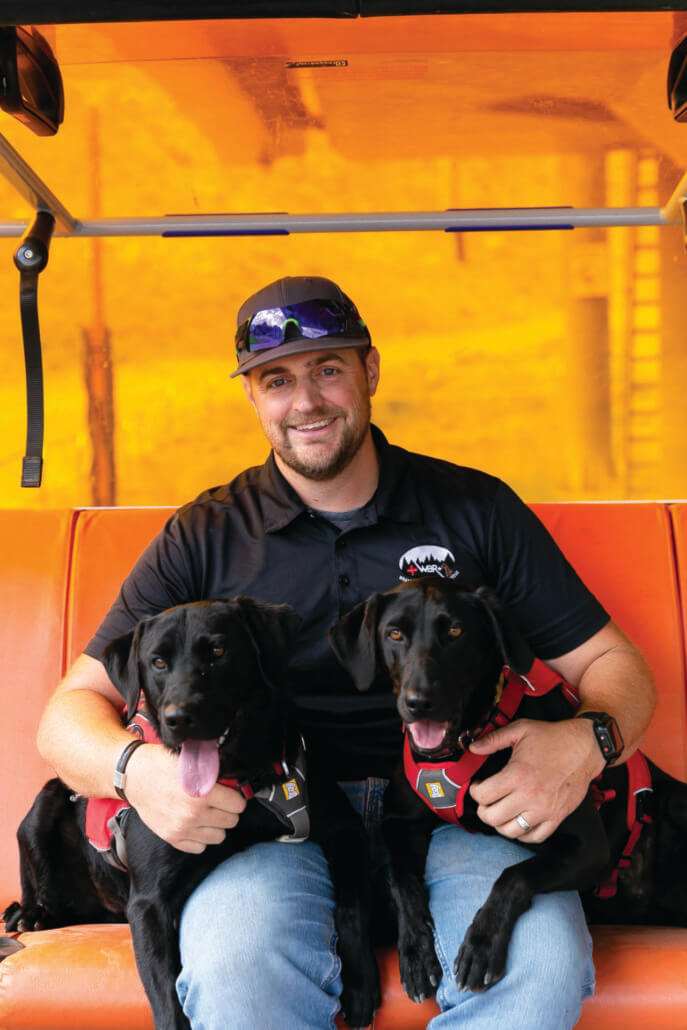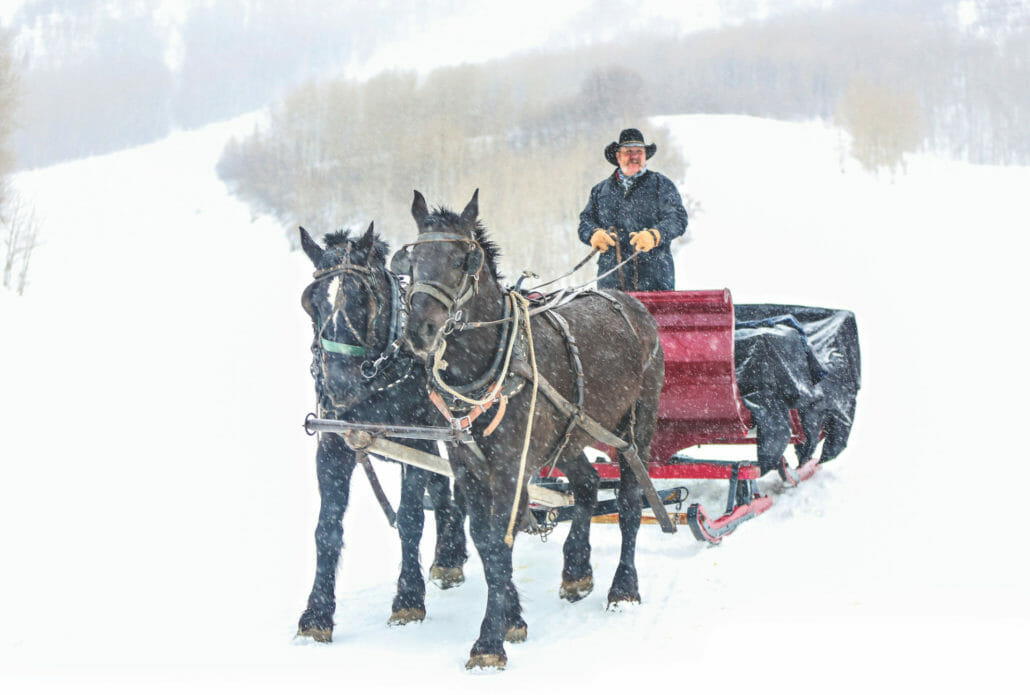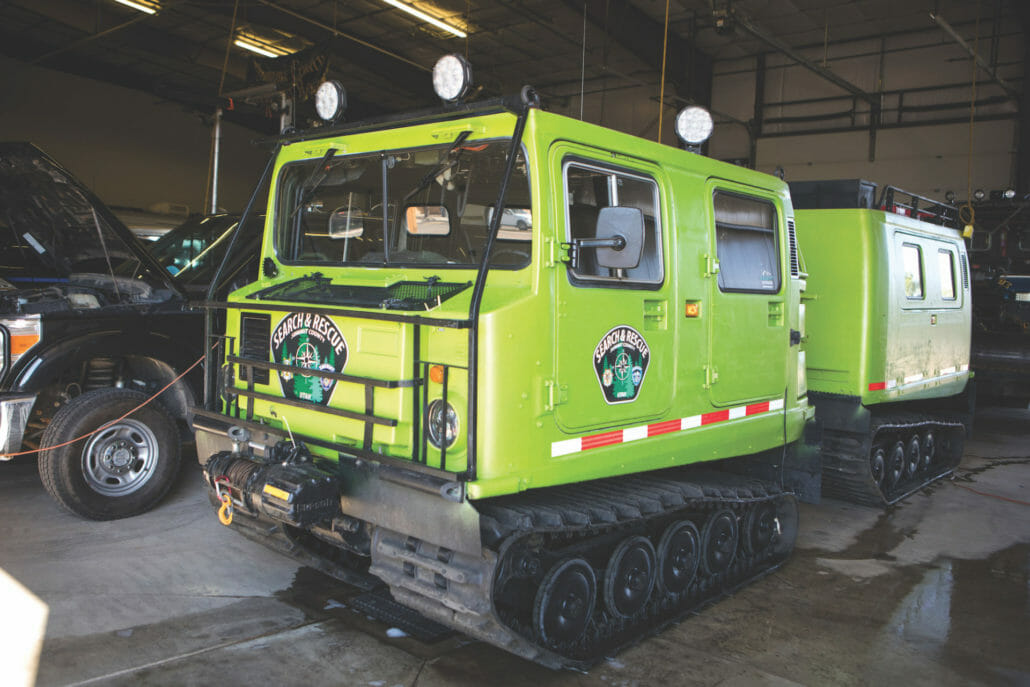
The furry faces of Park County’s ski patrol
Wasatch Backcountry Rescue shares what it takes to be an avalanche rescue dog
Winter/Spring 21-22
Written By: Ashley Brown | Images: Angela Howard
For some, saying hello to an avalanche rescue dog can be the most exciting part of the ski day.
The friendly faces of these pups offer encouragement to overwhelmed ski school participants and people injured on the mountain. And while avalanche dogs often bring joy and comfort, they’re there to work. As highly trained ski patrol members, each avalanche dog must undergo rigorous training that includes exposure to explosions, riding in helicopters, and locating human scent buried under the snow.
In Park City, the Wasatch Backcountry Rescue (WBR) is responsible for ensuring every dog you see on the mountain has completed the training and is ready to save a life. As one of the oldest avalanche rescue dog schools in the nation, WBR trains pups for all nine major Wasatch resorts — Park City, Deer Valley, Brighton, Solitude, Alta, Snowbird, Powder Mountain, Snowbasin, and Sundance.
The man running the show — both on and off the mountain — is Andy VanHouten. Andy volunteers with WBR as the organization’s president and works as the snow safety director and patrol manager at Park City Mountain Resort. He’s also the resort’s avalanche dog handler.
“The two jobs, patrol and WBR, overlap in so many ways. It is a fitting combination,” Andy says.
Andy’s interest in working with avalanche dogs began 19 years ago during his early years working on the mountain at Park City. “It’s something I’ve loved since my first year … I remember when I was a lift op, before I was on patrol, loading the dogs on Jupiter chair. I thought, ‘This is nuts. These dogs are the coolest thing I have ever seen. They ride chairlifts, snowmobiles, and helicopters.’”
So, Andy decided, “A.) I’ve got to get on patrol and B.) I’ve got to get more into this dog thing. As soon as I got on patrol, I started working with the dogs.”
When a ski patrol member decides to train an avalanche dog, it requires commitment and skill.
Known as the dog’s “handler,” the patroller is responsible for undergoing WBR training with the dog and providing the pup with a home. At Park City Mountain Resort, “We look for someone who has a good understanding of the job. … They exhibit good decision-making skills — that’s medical response, travel in avalanche terrain, and snow-safety skills.”
Beginning in puppyhood, the dogs go through a rigorous education program that utilizes WBR training methods. “Ideally, you can start to introduce the dog into resort operations around seven weeks old. The more you can get them on snowmobiles, chairlifts, and helicopters, the better,” Andy explains.

Both the avalanche dogs and handlers undergo an 18- to 24-month training that’s adapted from the Swiss “4-phase progression.” The first phase begins when the pup is between 6 and 12 months old, with a game of hide-and-seek and the reward of tug-of-war. “It’s this huge game of hide-and-seek. To the dogs, that is ultimately all this is, a game of hide-and-seek. We progressively make that harder,” Andy explains.
During the next phase, the handler hides in a large snow cave until the dog finds the handler and plays tug-of-war in the hole. The third phase involves filling in the entrance of the snow cave so the dog must dig to find their handler and the toy. A stranger replaces the handler during the fourth phase.
Completion of these four phases earns the dog a Level C certification from WBR, which also offers a Level B and A certification. When the dog can locate two avalanche victims in under 20 minutes on a one-hectare test site and pass an obedience test, they earn a Level B or ski resort dog certification. Level B dogs respond to avalanche incidents in or near ski resorts.
For the Level A test, the handler must demonstrate efficiency, identify hazards, and formulate a search plan, and the dog and team must find all victims on the one-hectare avalanche test site in less than 20 minutes, showing physical fitness and endurance for the duration of the rescue. A team with a Level A certification can respond to rescue calls throughout the state of Utah.
All the hard work is evident when the dog has the chance to practice their training.
“We bring dogs in and within minutes, the dogs have found the person,” Andy says. Unfortunately, it takes time for the team to get to an accident, so sometimes the dogs recover avalanche fatalities. Even then, the dog’s role in the search is critical. “The dogs are an unbelievable tool to bring closure to families,” Andy explains.
While the avalanche dogs role in a recovery or search is serious, on the mountain, their presence is a source of delight. “What we do with the dogs on a daily basis is meet and greets. The skiing public loves these dogs,” Andy says. “We started baseball cards … it’s turned into a huge deal for kids to try to collect all the dog cards.”
The next time you say hello to an avalanche dog, just remember: They’re so much more than just a friendly, furry face.

